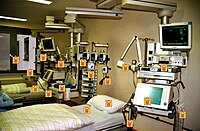
Characteristics of ST11 KPC‐2‐producing carbapenem‐resistant hypervirulent Klebsiella pneumoniae causing nosocomial infection in a Chinese hospital
Sign Up to like & getrecommendations! Published in 2022 at "Journal of Clinical Laboratory Analysis"
DOI: 10.1002/jcla.24476
Abstract: The purpose of our study is to analyze the microbiological and clinical characteristics of carbapenem‐resistant hypervirulent Klebsiella pneumoniae (CR‐hvKP) that causes nosocomial infection. read more here.
Keywords: carbapenem resistant; hypervirulent klebsiella; klebsiella pneumoniae; resistant hypervirulent ... See more keywords

Molecular Characterization of Carbapenem-Resistant Acinetobacter baumannii Associated with Nosocomial Infection in the Pelotas, RS, Brazil
Sign Up to like & getrecommendations! Published in 2020 at "Current Microbiology"
DOI: 10.1007/s00284-020-02060-w
Abstract: Acinetobacter calcoaceticus–Acinetobacter baumannii complex (ACB) comprises some opportunistic pathogens associated with infectious outbreaks in hospital settings. A. baumannii is the most relevant species owing to its capacity to develop resistance to the different classes of… read more here.
Keywords: nosocomial infection; associated nosocomial; pelotas brazil; acinetobacter baumannii ... See more keywords

A quick evaluation method of nosocomial infection risk for cancer hospitals during the COVID-19 pandemic
Sign Up to like & getrecommendations! Published in 2020 at "Journal of Cancer Research and Clinical Oncology"
DOI: 10.1007/s00432-020-03235-5
Abstract: Nosocomial infections caused by COVID-19 will result in the immediate closure of the infected medical facility due to the highly contagious nature of COVID-19, further worsening medical shortages. We performed a Delphi consulting study to… read more here.
Keywords: risk; nosocomial infection; method; cancer ... See more keywords

Novel curcumin analogs act as antagonists to control nosocomial infection causing Pseudomonas aeruginosa
Sign Up to like & getrecommendations! Published in 2019 at "Biocatalysis and Agricultural Biotechnology"
DOI: 10.1016/j.bcab.2019.101238
Abstract: Abstract Pseudomonas aeruginosa has become the important cause of hospital acquired nosocomial infection which is one of the leading cause of death in today's world. Here, we synthesized structurally similar analogs of curcumin (G0-G4) as… read more here.
Keywords: curcumin analogs; novel curcumin; pseudomonas aeruginosa; nosocomial infection ... See more keywords

Nosocomial infection with SARS-Cov-2 within Departments of Digestive Surgery
Sign Up to like & getrecommendations! Published in 2020 at "Journal of Visceral Surgery"
DOI: 10.1016/j.jviscsurg.2020.04.016
Abstract: Summary Introduction The COVID-19 pandemic imposed a drastic reduction in surgical activity in order to respond to the influx of hospital patients and to protect uninfected patients by avoiding hospitalization. However, little is known about… read more here.
Keywords: nosocomial infection; infection; infection sars; digestive surgery ... See more keywords

Clinical effect of standardized nursing for lymphoma patients and the influencing factors of nosocomial infection
Sign Up to like & getrecommendations! Published in 2023 at "Medicine"
DOI: 10.1097/md.0000000000032624
Abstract: To analyze the clinical effect of standardized nursing for lymphoma patients and the influencing factors of nosocomial infection, a total of 360 diffuse large B-cell lymphoma patients with disease recurrence or progression after first-line treatment… read more here.
Keywords: infection; standardized nursing; clinical effect; nosocomial infection ... See more keywords

Immunoparalysis in critically ill children
Sign Up to like & getrecommendations! Published in 2022 at "Immunology"
DOI: 10.1111/imm.13595
Abstract: Immunoparalysis is associated with poorer outcomes in the paediatric intensive care unit (PICU) setting. We aimed to determine the group of patients with higher chances of immunoparalysis and correlate this status with increased risks of… read more here.
Keywords: frequency; immunoparalysis; classical monocytes; monocytes producing ... See more keywords

Affordable measures to monitor and alarm nosocomial SARS‐CoV‐2 infection due to poor ventilation
Sign Up to like & getrecommendations! Published in 2021 at "Indoor Air"
DOI: 10.1111/ina.12899
Abstract: Abstract Since the coronavirus disease 2019 (COVID‐19) outbreak, the nosocomial infection rate worldwide has been reported high. It is urgent to figure out an affordable way to monitor and alarm nosocomial infection. Carbon dioxide (CO2)… read more here.
Keywords: ventilation; nosocomial infection; infection; co2 concentration ... See more keywords

Effect of Operating Room Nursing Management on Nosocomial Infection in Orthopedic Surgery: A Meta-Analysis
Sign Up to like & getrecommendations! Published in 2022 at "Journal of Healthcare Engineering"
DOI: 10.1155/2022/4193932
Abstract: Objective This study aimed to provide scientific management methods to prevent nosocomial infection based on the systematical evaluation of the effect of operating room nursing management on nosocomial infection in orthopedic surgery. Methods PubMed, Web… read more here.
Keywords: nosocomial infection; infection; operating room; nursing management ... See more keywords

Low incidence of multidrug-resistant bacteria and nosocomial infection due to a preventive multimodal nosocomial infection control: a 10-year single centre prospective cohort study in neurocritical care
Sign Up to like & getrecommendations! Published in 2018 at "BMC Neurology"
DOI: 10.1186/s12883-018-1031-6
Abstract: BackgroundNosocomial infection (NI) control is an important issue in neurocritical care due to secondary brain damage and the increased morbidity and mortality of primary acute neurocritical care patients. The primary aim of this study was… read more here.
Keywords: neurocritical care; infection control; nosocomial infection; infection ... See more keywords

Randomized community trial on nosocomial infection control educational module for nurses in public hospitals in Yemen: a study protocol
Sign Up to like & getrecommendations! Published in 2019 at "BMC Nursing"
DOI: 10.1186/s12912-019-0333-3
Abstract: BackgroundNosocomial infections remain a global health problem and they are considered as one of the leading causes of increased morbidity and mortality. In-service training courses related to infection control measures can help nurses to make… read more here.
Keywords: educational module; infection control; nosocomial infection; module ... See more keywords